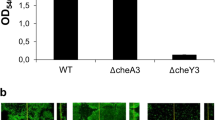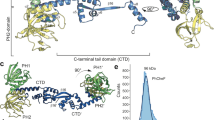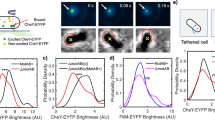Abstract
Phosphotransfer between the autophosphorylating histidine kinase CheA and the response regulator CheY represents a crucial step in the bacterial chemotaxis signal transduction pathway. The 15N–1H correlation spectrum of CheY complexed with an amino-terminal fragment of CheA exhibits specific localized differences in chemical shifts when compared to the spectrum of uncompiexed CheY. When mapped onto the three-dimensional structure of CheY, these changes define a region distinct from the active site. A single amino-acid substitution within this binding region on CheY, alanine to valine at position 103, significantly decreases the affinity of CheY for CheA. The binding face described by these changes partially overlaps a flagellar switch binding surface previously defined by mutagenesis.
This is a preview of subscription content, access via your institution
Access options
Subscribe to this journal
Receive 12 print issues and online access
209,00 € per year
only 17,42 € per issue
Buy this article
- Purchase on SpringerLink
- Instant access to full article PDF
Prices may be subject to local taxes which are calculated during checkout
Similar content being viewed by others
References
Stock, J.B., Surette, M.G., McCleary, W.R. & Stock, A.M. Signal transduction in bacterial chemotaxis. J. biol. Chem. 267, 19753–19756 (1992).
Bourret, R.B., Borkovich, K.A. & Simon, M.I. Signal transduction pathways involving protein phosphorylation in prokaryotes. A. Rev. Biochem. 60, 401–441 (1991).
Alex, L.A. & Simon, M.I. Protein histidine kinases and signal transduction in prokaryotes and eukaryotes. Trends Genet. 10, 133–138 (1994).
Stock, J.B., Ninfa, A.J. & Stock, A.M. Protein phosphorylation and regulation of adaptive responses in bacteria. Microbiol. Rev. 53, 450–490 (1989).
Parkinson, J.S. & Kofoid, E.C. Communication modules in bacterial signaling proteins. A. Rev. Genet. 26, 71–112 (1992).
Swanson, R.V. & Simon, M.I. Signal transduction: bringing the eukaryotes up to speed. Curr. Biol. 4, 234–237 (1994).
Borkovich, K.A., Kaplan, N., Hess, J.F. & Simon, M.I. Transmembrane signal transduction in bacterial chemotaxis involves ligand-dependent activation of phosphate group transfer. Proc. natn. Acad. Sci. U.S.A. 86, 1208–1212 (1989).
Borkovich, K.A. & Simon, M.I. The dynamics of protein phosphorylation in bacterial chemotaxis. Cell 63, 1339–1348 (1990).
Ninfa, E.G., Stock, A., Mowbray, S. & Stock, J. Reconstitution of the bacterial chemotaxis signal transduction system from purified components. J. biol. Chem. 266, 9764–9770 (1991).
Borkovich, K.A., Alex, L.A. & Simon, M.I. Attenuation of sensory receptor signaling by covalent modification. Proc. natn. Acad. Sci. U.S.A. 89, 6756–6760 (1992).
Gegner, J.A., Graham, D.R., Roth, A.F. & Dahlquist, F.W. Assembly of an MCP receptor, CheW, and kinase CheA complex in the bacterial chemotaxis signal transduction pathway. Cell 70, 975–982 (1992).
Schuster, S.C., Swanson, R.V., Alex, L.A., Bourret, R.B. & Simon, M.I. Assembly and function of a quaternary signal transduction complex monitored by surface plasmon resonance. Nature 365, 343–347 (1993).
Hess, J.F., Oosawa, K., Kaplan, N. & Simon, M.I. Phosphorylation of three proteins in the signaling pathway of bacterial chemotaxis. Cell 53, 79–87 (1988).
Stock, A., Koshland, Jr., D.E. & Stock, J. Homologies between the Salmonella typhimurium CheY protein and proteins involved in the regulation of chemotaxis, membrane protein synthesis, and sporulation. Proc. natn. Acad. Sci. U.S.A. 82, 7989–7993 (1985).
Stewart, R.C., Roth, A.F. & Dahlquist, F.W. Mutations that affect control of the methylesterase activity of CheB, a component of the chemotaxis adaptation system in Escherichia coli . J. Bact. 172, 3388–3399 (1990).
Lupas, A. & Stock, J. Phosphorylation of an N-terminal regulatory ___domain activates the CheB methylesterase in bacterial chemotaxis. J. biol. Chem. 264, 17337–17342 (1989).
Sanders, D.A., Gillece-Castro, B.L., Burlingame, A.L. & Koshland, Jr., D.E. Phosphorylation site of NtrC, a protein phosphatase whose covalent intermediate activates transcription. J. Bact. 174, 5117–5122 (1992).
Lukat, G.S., McCleary, W.R., Stock, A.M. & Stock, J.B. Phosphorylation of bacterial response regulator proteins by low molecular weight phospho-donors. Proc. natn. Acad. Sci. U.S.A. 89, 718–722 (1992).
Stock, A.M., Martinez-Hackert, E., Rasmussen, B.F., West, A.H., Stock, J.B., Ringe, D. & Petsko, G.A. Structure of the Mg(2+)-bound form of CheY and mechanism of phosphoryl transfer in bacterial chemotaxis. Biochem. 32, 13375–13380 (1993).
Volz, K. Structural conservation in the CheY superfamily. Biochem. 32, 11741–11753 (1994).
McNally, D.F. & Matsumura, P. Bacterial chemotaxis signaling complexes: formation of a CheA/CheW complex enhances autophosphorylation and affinity for CheY. Proc. natn. Acad. Sci. U.S.A. 88, 6269–6273 (1991).
Swanson, R.V., Schuster, S.C. & Simon, M.I. Expression of CheA fragments which define domains encoding kinase, phosphotransfer, and CheY binding activities. Biochem. 32, 7623–7629 (1993).
Bruix, M., Pascual, J., Santoro, J., Prieto, J., Serrano, L. & Rico, M. 1H- and 15N-NMR assignment and solution structure of the chemotactic Escherichia coliCheY protein. Eur. J. Biochem. 215, 573–585 (1993).
Moy, F.J., Matsumura, P., Lowry, D., Dahlquist, F.W. & Domaille, P.J., Assignments, secondary structure, global fold, and dynamics of chemotaxis Y protein using three- and four-dimensional heteronuclear (13C, 15N) NMR spectroscopy. Biochemistry 33, 10731–10742 (1994).
Gegner, J.A. & Dahlquist, F.W. Signal transduction in bacteria: CheW forms a reversible complex with the protein kinase, CheA. Proc. natn. Acad. Sci. U.S.A. 88, 750–754 (1991).
Morrison, T.B. & Parkinson, J.S. Liberation of an interaction ___domain from the phosphotransfer region of CheA, a signaling kinase of Escherichia coli . Proc. natn. Acad. Sci. U.S.A. 91, 5485–5489 (1994).
Volz, K. & Matsumura, P. Crystal structure of Escherichia coliCheY refined at 1.7 Å resolution. J. biol. Chem. 266, 15511–15519 (1991).
Hess, J.F., Bourret, R.B., Simon, M.I. Histidine phosphorylation and phosphoryl group transfer in bacterial chemotaxis. Nature 336, 139–143 (1988).
Lowry, D.F., Roth, A.F., Rupert, P.B., Moy, F.J., Domaille, P.J. & Matsumura, P. Signal transduction in chemotaxis. A propagating conformation change upon phosphorylation of CheY. J. biol. Chem. 269, 26358–26362 (1994).
Blat, Y. & Eisenbach, M. Phosphorylation-dependent binding of the chemotaxis signal molecule CheY to its phosphatase, CheZ. Biochem. 33, 902–906 (1994).
Welch, M., Oosawa, K., Aizawa, S. & Eisenbach, M. Phosphorylation-dependent binding of a signal molecule to the flagellar switch of bacteria. Proc. natn. Acad. Sci. U.S.A. 90, 8787–8791 (1993).
Roman, S.J., Meyers, M., Volz, K. & Matsumura, P. A chemotactic signaling surface on CheY defined by suppressors of flagellar switch mutations. J. Bact. 174, 6247–6255 (1992).
Sockett, H., Yamaguchi, S., Kihara, M., Irikura, M.V. & Macnab, R.M. Molecular analysis of the flagellar switch protein FliM of Salmonella typhimurium . J. Bact. 174, 793–806 (1992).
Bourret, R.B., Hess, J.F. & Simon, M.I. Conserved aspartate residues and phosphorylation in signal transduction by the chemotaxis protein CheY. Proc. natn. Acad. Sci. U.S.A. 87, 41–45 (1990).
McEvoy, M.M., Zhou, H., Roth, A.F., Lowry, D.F., Morrison, T.B., Kay, L.E. & Dahlquist, F.W. Nuclear magnetic resonance assignments and global fold of a CheY-binding ___domain in CheA, the chemotaxis-specific kinase of E. coli . Biochemistry, in the press.
Gill, S.C. & von Hippel, P.H. Calculation of protein extinction coefficients from aminoacid sequence data. Anal. Biochem. 182, 391–326 (1989).
Kraulis, P.J. MOLSCRIPT: a program to produce both detailed and schematic plots of protein structures. J. appl. Crystallogr. 24, 946–950 (1991).
Author information
Authors and Affiliations
Rights and permissions
About this article
Cite this article
Swanson, R., Lowry, D., Matsumura, P. et al. Localized perturbations in CheY structure monitored by NMR identify a CheA binding interface. Nat Struct Mol Biol 2, 906–910 (1995). https://doi.org/10.1038/nsb1095-906
Received:
Accepted:
Published:
Issue Date:
DOI: https://doi.org/10.1038/nsb1095-906
This article is cited by
-
Structure of the CheY-binding ___domain of histidine kinase CheA in complex with CheY
Nature Structural Biology (1998)



